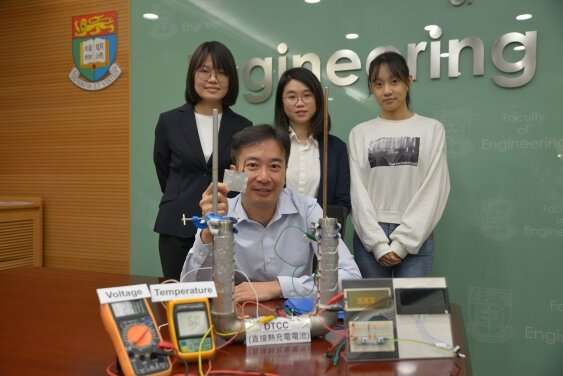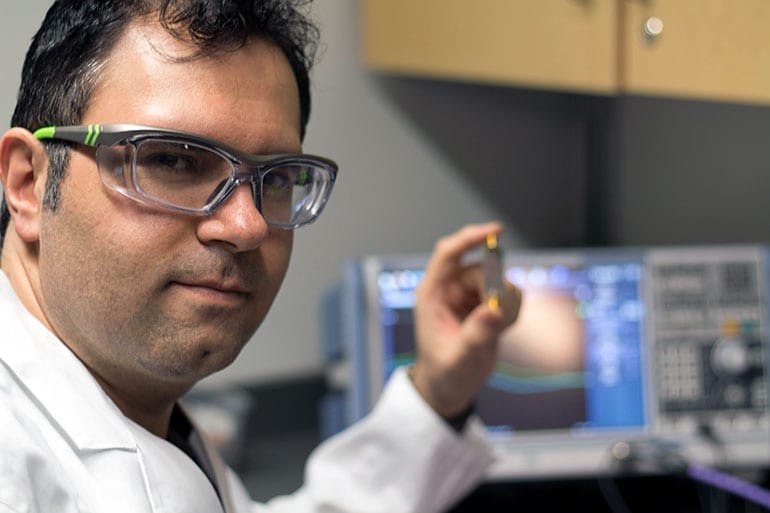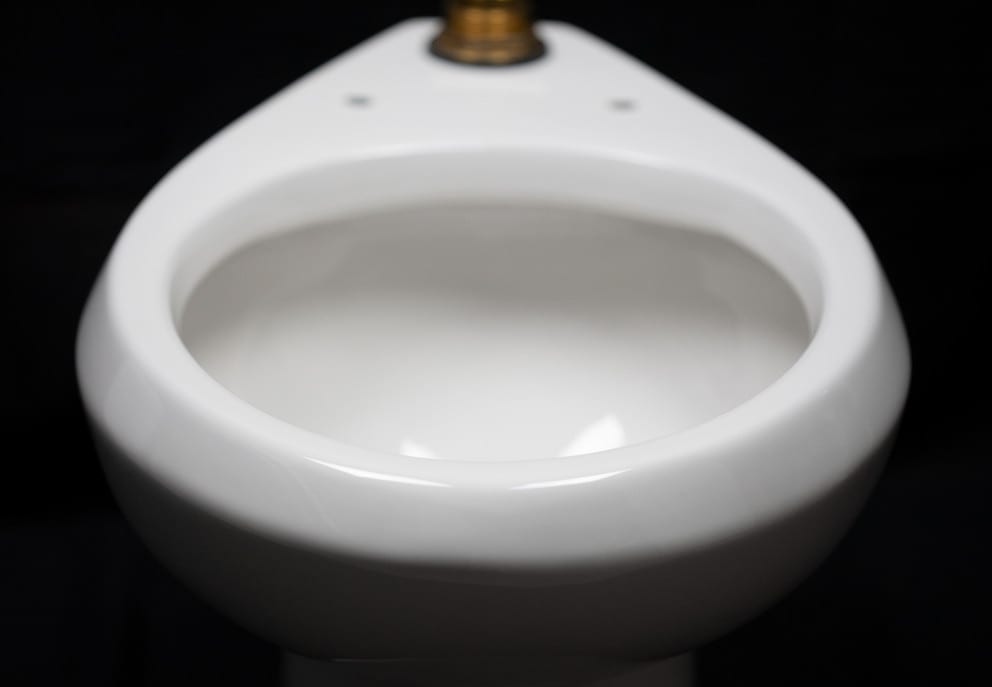
Dr Tony Shien-Ping Feng of the Department of Mechanical Engineering at the University of Hong Kong (HKU) and his team invented a Direct Thermal Charging Cell (DTCC) which can effectively convert heat to electricity, creating a huge potential to reduce greenhouse effects by capturing exhaust heat and cutting down primary energy wastage.
The new invention is recently published in the prestigious journal Nature Communications (http://www.i-nanoeng.com/upload/2019/09/20190918160051.pdf), and the research has been featured in the Nature Communications Editors’ Highlights webpage. HKU’s Technology Transfer Office has filed for the invention’s US provisional patent and PCT (Patent Cooperation Treaty) patent.
Low grade heat is abundantly available in industrial processes (80 to 150°C), as well as in the environment, living things, solar-thermal (50 to 60°C) and geothermal energy. Over 60% of the world’s primary energy input, whether it is in the industrial process or domestic energy consumption, is wasted as heat. A majority of this loss as waste heat is regarded as low-grade heat.
The newly designed DTCC is a game-changing electrochemical technology which can open new horizons for applications to convert low-grade heat to electricity efficiently. It is a simple system with the basic unit sized only 1.5 sq.cm and thickness 1 to 1.5 mm. The cell is bendable, stackable and low cost.
DTCC can be used in HVAC (heating, ventilation, and air conditioning) system to recycle low-grade heat from the compressor and condenser into electricity for use in electrical devices. It can be integrated with the window frame to harvest solar thermal energy to power electrochromic windows, or used as portable devices to power iphones or life-saving equipment in the wilderness. With the increasing popularity of wearable technology, this system may one day harness body heat to power wearable electronic devices or medical devices for monitoring body health conditions like blood sugar levels and blood pressure.
Dr Feng said: “Efficient low-grade heat recovery can help to reduce greenhouse gas emission but current technologies to convert this heat to electricity is still far from optimum. DTCC yields a conversion efficiency of over 3.5%, surpassing all existing thermo-electrochemical and thermo-electric systems, which is either too costly or complicated, or too low in efficiency for everyday applications. DTCC is a revolutionary design with great potentials in smart and sustainable energy devices.”
The new thermal charging cell uses asymmetric electrodes: a graphene oxide/platinum (GO/Pt) cathode and a polyaniline (PANI) anode in Fe2+/Fe3+ redox electrolyte via isothermal heating operation without building thermal gradient or thermal cycle. When heated, the cell generates voltage via a thermo-pseudocapacitive effect of GO and then discharges continuously by oxidizing the PANI anode and reducing Fe3+ to Fe2+ under isothermal heating on cathode side till Fe3+ depletion. The energy conversion works continuously under isothermal heating during the entire charge and discharge process. The system can be self-regenerated when cooled down. This synergistic chemical regeneration mechanism allows the device cyclability.
The Latest on: Direct Thermal Charging Cell
- Mercedes-AMG’s latest GT rockets 0-60mph in 2.7 secondson April 23, 2024 at 7:51 am
Mercedes-AMG's new flagship, the GT 63 S E Performance, goes 0-60 mph in 2.7 seconds, the fastest sprint ever for an AMG series model.
- Charging ahead: The quest for clean energy and safer battery storageon April 22, 2024 at 10:31 am
Climate change is driving the transition toward clean energy and storage. Lithium-ion battery technology, while promising, suffers from some issues. Developers are working on solutions and ...
- Review: BYD Seal 2024on April 22, 2024 at 1:54 am
Nice handling. Good value. Pleasing design and cabin. Cell-to-body battery technology. Now though—and just as the Koreans have, too—BYD wants to head upmarket. It intends to do so with the ...
- Preventing thermal runaway at every level of EV battery assemblyon April 21, 2024 at 3:07 am
There is currently a lack of clear regulation around TRP standards. But across the industry, many OEMs have adopted the “5-minute rule” as the standard, meaning if a thermal runaway event happens, ...
- Expion360 Announces Substantial Preorders of Next Generation Lithium Batteries Now Featuring Vertical Heat Conduction™ Heating Technologyon April 18, 2024 at 7:31 am
Expion360 Inc. (Nasdaq: XPON) (“Expion360” or the “Company”), an industry leader in lithium-ion battery power storage solutions, today announced substantial preorders of its next generation Group 27 ...
- Tapping Secrets of Li-ion Cell Temperature to Improve Cold Performanceon April 17, 2024 at 7:57 am
Existing and emerging methods for determining internal cell temperatures ... a battery thermal-management system (BTMS). Of course, under warm conditions, a concern is that charging that is ...
- New device gathers, stores electricity in remote settingson April 8, 2024 at 5:00 pm
The study, titled "Direct Conversion of Thermal Energy to Stored Electrochemical Energy via a Self-Charging Pyroelectrochemical Cell," was funded by the National Science Foundation. Also ...
- Mismatch voltage & thermal patterns in half-cell bifacial technologyon April 7, 2024 at 5:00 pm
The study on “Thermal issues on half-cell bifacial modules. A way through albedo and mismatch voltage”, presented by Enertis Applus+ at this year’s EU PVSEC conference, offers an intriguing ...
- New Dodge Charger Unveiled as "World's First and Only" Electric Muscle Caron March 13, 2024 at 8:39 pm
The 2024 Dodge Charger Daytona Scat ... The battery cell structure is prismatic, offering a more structurally stable cell with better thermal performance through a rigid casing, resulting in ...
- Thermal Analysis, Microfluidics, and Fuel Cell Laboratoryon September 8, 2022 at 12:00 pm
Since its inception in 1990, the RIT Thermal Analysis and Microfluidics lab has been driven by a keen desire to examine the fundamental phenomena related to microscale fluid mechanics and dynamics.
via Bing News
The Latest on: Converting heat to electricity
- Energy Efficiency is Critical for a Sustainable Futureon April 26, 2024 at 9:00 am
Governments must prioritize energy efficiency and reduce energy waste to achieve clean energy security and combat climate change.
- One N.H. town is trying to decarbonize their buildings — and build a workforce in the processon April 26, 2024 at 3:48 am
With federal money and local support, Peterborough, New Hampshire is hoping to electrify 200 heating systems in the next three years. They’re also trying to train more people to do that work.
- ECoS will be empowered to regulate ocean heat energy in Sabahon April 25, 2024 at 4:50 am
Bill 2024 on Thursday to include the term “ocean thermal” in the definition of “renewable energy” as one of the energies to be comprehensively regulated by the Sabah Energy Commission (ECoS). Assistan ...
- Assembly Speaker Carl Heastie isn’t ruling out passing NY HEAT this yearon April 24, 2024 at 6:17 pm
Advocates blame the state Assembly for killing the NY HEAT bill, but Speaker Carl Heastie said Wednesday that he’s not ruling out passing it before the session ends.
- Using liquid metal to develop energy storage systems with 100 times better heat transferon April 24, 2024 at 12:57 pm
The industrial production of steel, concrete, or glass requires more than 20% of Germany's total energy consumption. Up to now, 90% of the fuels used for these processes have been of fossil nature.
- Making Carbon Neutrality a Reality at DUon April 24, 2024 at 5:00 am
The University of Denver is taking a bold step toward reaching its goal of carbon neutrality by the year 2030. Today, the University announced a new partnership with solar power company Pivot Energy ...
- Energy Storage Systems: 100 Times Better Heat Transfer Thanks to the Use of Liquid Metalon April 24, 2024 at 1:03 am
The industrial production of steel, concrete, or glass requires more than 20 percent of Germany’s total energy consumption. Up to now, 90 percent of ...
- Harnessing heat: UD, AES Ohio, Tallgrass sign pact to power UD campuson April 23, 2024 at 2:56 am
Kanin Energy, with whom Tallgrass has collaborated on the system, says it specializes in turning industrial waste heat into clean electricity, boosting energy efficiency. Under the agreement, AES Ohio ...
- Tech Leaders Big Big On Green Energy Startupson April 22, 2024 at 2:00 pm
Sam Altman and Andreessen Horowitz are investing in Exowatt, a clean energy startup aiming to provide solar power and energy storage solutions for AI data centers and the electrification of the ...
- Ion thermoelectric conversion devices for near room temperatureon April 22, 2024 at 1:59 pm
The electrode sheet of a thermoelectric device consists of ionic hydrogel, which is sandwiched between the electrodes to form, and the Prussian blue on the electrode undergoes a redox reaction to ...
via Bing News










